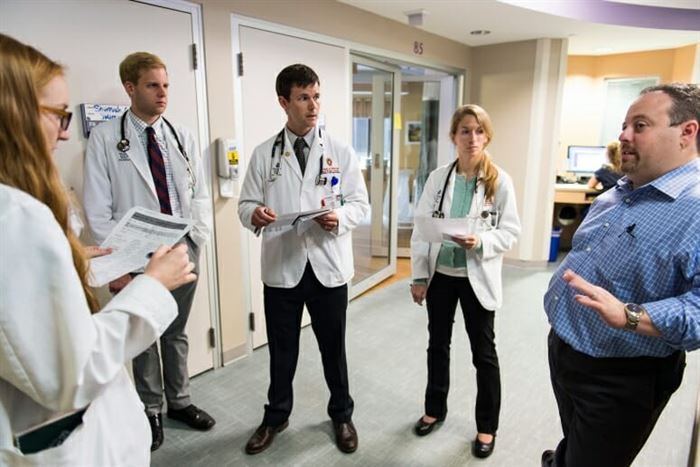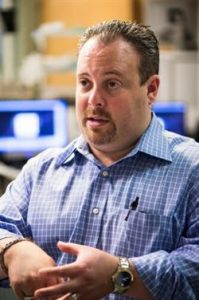2.1.18 | UW–Madison News | David Tenenbaum | Original Publication
A UW–Madison spinoff is refining a medical management package designed to help doctors treat patients more efficiently.
To gain acceptance at hospitals, Integrated Vital Medical Dynamics LLC is trying to prove that ideas from its “Digital Intern” software will help doctors improve results.
Company founder Joshua Medow, a professor of neurosurgery at UW Hospital, says Digital Intern is not a “robot doctor,” but rather a new form of doctor’s assistant. “The doctor sets the goals for each patient, for example, for blood pressure and hemoglobin level, and then the Intern tries to reach the goals. Using information from sources like the electronic medical record, the Intern proposes one or more courses of treatment.”

The treating physician, Medow insists, “can decide to use the Digital Intern’s approach — or do something entirely different. The only thing that’s automatic here is our ability to make instant, reasonable suggestions that meet the needs of the patient.”
In an early study testing use of the Intern to sustain organ donors, costs were reduced, yet organ procurement rates rose. In more recent studies, the Digital Intern reduced in-patient use of blood products. Eliminating inappropriate use could reduce blood usage by about 50 percent, Medow says.
The Intern has a much broader scope than transfusions, Medow says. “We can help manage patients with problems related to sepsis (systemic infection), blood pressure, heart rhythm, bleeding, breathing, fluids, electrolytes, nutrition, infection, pain, even agitation.”
The Intern is built on algorithms — elaborate versions of logical structures that say, “In these conditions, do this.”
The 40-plus algorithms already inside Digital Intern converse among themselves as necessary. “We have intertwined algorithms that deal with blood pressure, fluid levels, medication, heart rate, cardiac output,” Medow says.
More algorithms are in the pipeline, he adds, and the Intern will soon begin helping write doctor and nursing notes.
Digital Intern is a state-of-the-art incarnation of evidence-based medicine — the ongoing quest to base decisions on available data and rigorous analysis rather than experience and gut instinct.
Medow, who is close to earning a Ph.D. in clinical investigation and informatics, says evidence-based medicine grows more complex by the month. Even specialists may have difficulty, especially under time pressure, following the paper-based “decision trees” that are the embodiment of this fairly new style of medicine.
Decision trees can be convoluted, Medow says. “It’s ‘with this patient, under these circumstances, to meet your goals, here are three medicines to try, but watch for these two drug interactions and these five side effects. And be sure to monitor these electrolytes for at least 24 hours.’”
And that’s only a rudimentary example of the kind of algorithm that underlies Digital Intern, Medow says.
Whether the physician follows the advice or not, the Intern will monitor the patient and render further advice as appropriate. “I compare us to autopilot on an airplane,” says Medow. “The Intern doesn’t bother you — the doctor — unless it suggests something that was flagged as needing your approval, but when minutes count, the advice is always up-to-the-minute.”
A skeptical physician can press the “i” button on screen to see the medical literature supporting a suggestion.

Medow is the founder and director of the Neurointensive Care Unit at UW Hospital, which treats strokes, accidents and gunshots, and he knows about high-pressure medical decisions. For most Neuro ICU patients, he says, “time is brain” is not just a truism. It’s truth.
Integrated Vital Medical Dynamics has two employees. A total of 16 people are contributing to its efforts as advisors, consultants or coders.
The package was so named, Medow explains, “because it follows how attending physicians work with interns in the hospital. The attending says, ‘I want you to get systolic blood press between 100 and 130.’ The machine (like an intern) says, ‘Okay, no problem.’ And the physician says, ‘By the way, I want the heart rate between 60 and 100,’ and the machine says, ‘No problem.’ Then it brings all these requirements together and offers a solution.”
The solution, he stresses, is just an informed suggestion, not a requirement.
“Every action is a test dose for the next action,” Medow says. “What works for you may not work for me. We keep learning, adapting, trying to reach the goals, and provide minute-to-minute adjustments as needed, no problem.”
Supporting the program are Medow’s multiple interests and expertise: He’s licensed and board-certified as a physician and surgeon to work in neurosurgery, intensive care and clinical informatics. “We incorporate knowledge from all the major fields with direct patient care: neurology and neurosurgery, nephrology, burn medicine, pediatrics, general internal medicine, cardiology, critical care, pulmonology, nutrition, gastrointestinal medicine, hematology, transfusion medicine and endocrinology.”
In a nation stressed by the cost of health care, software that aids difficult medical decisions can “extend your reach to manage more patients safely with greater efficiency and effectiveness,” Medow says.
“Our mission is to improve the lives of patients and those who care for them,” he adds. “We are not replacing doctors, but that is a concern that many doctors have. The doctor determines the goals, and can choose to follow the Digital Intern’s suggestions, or do something else. The software will not feel insulted if the physician has a better idea!”